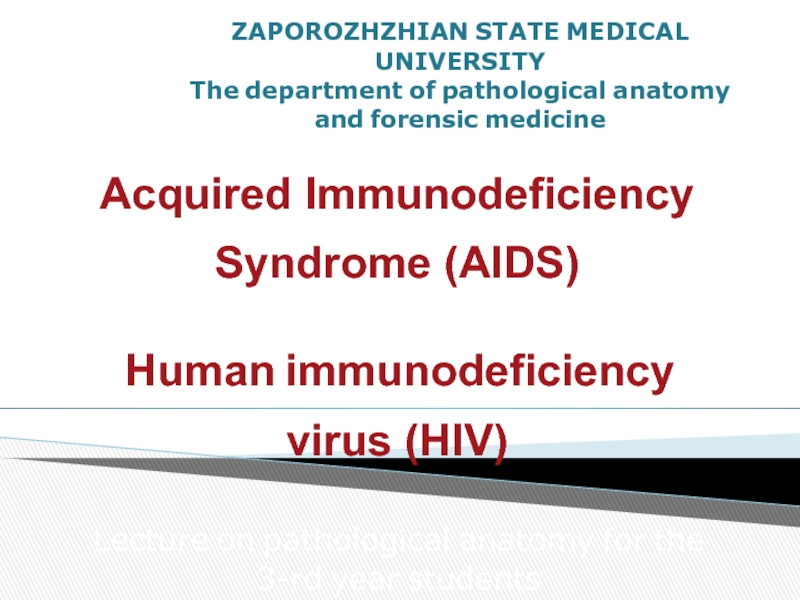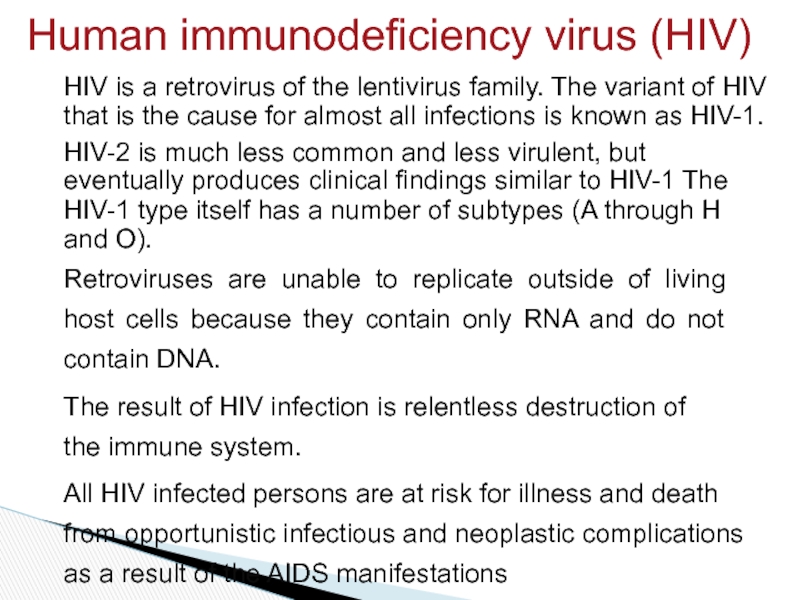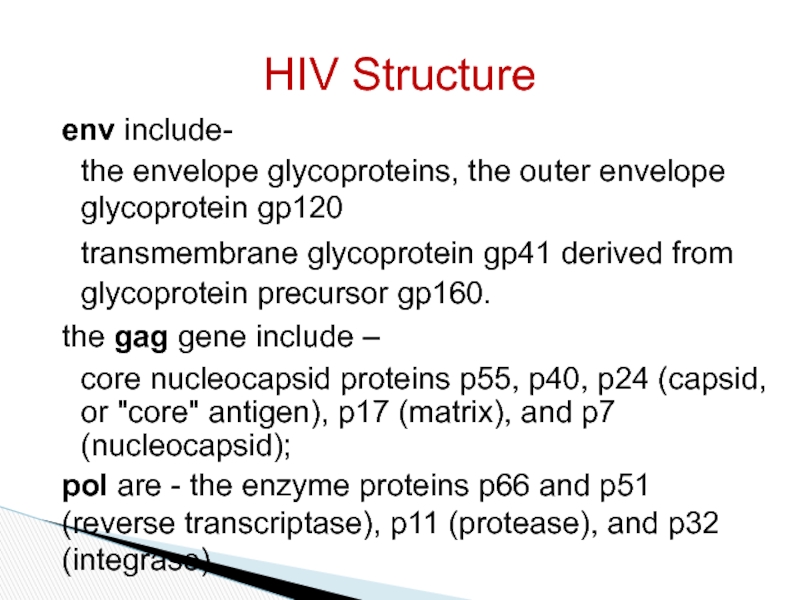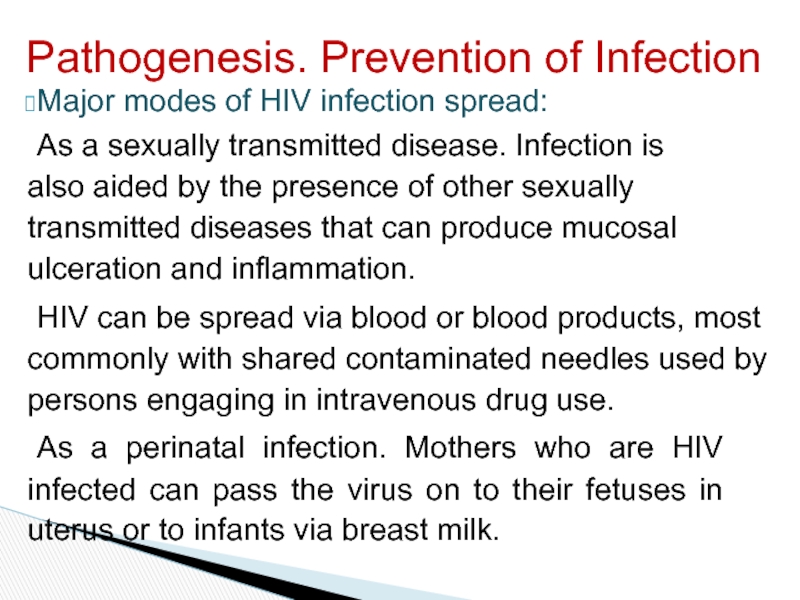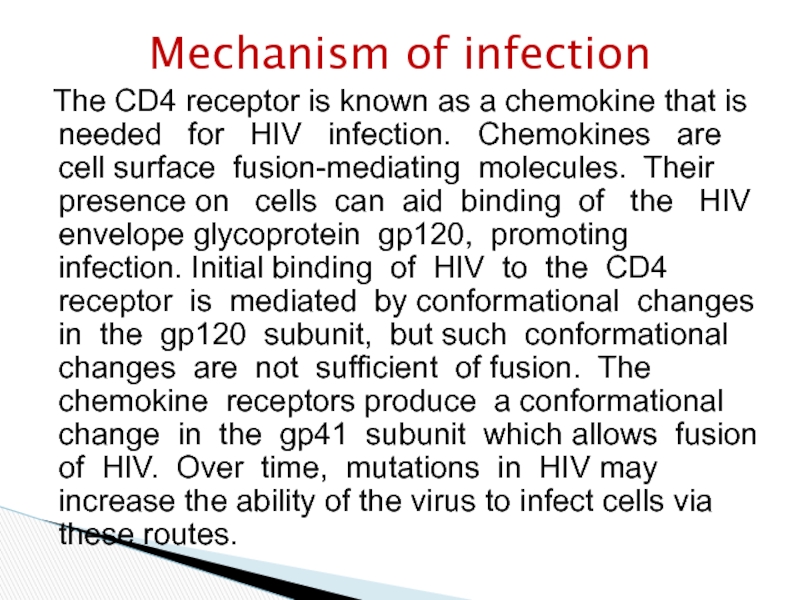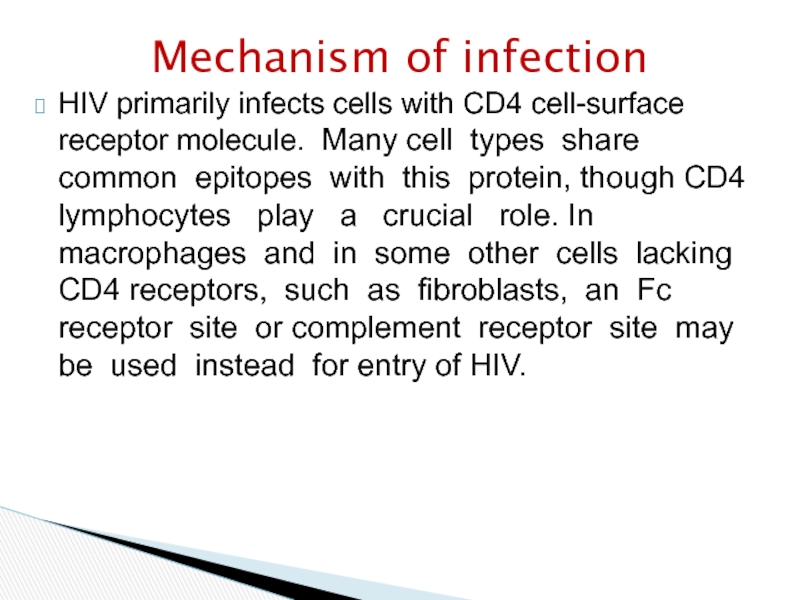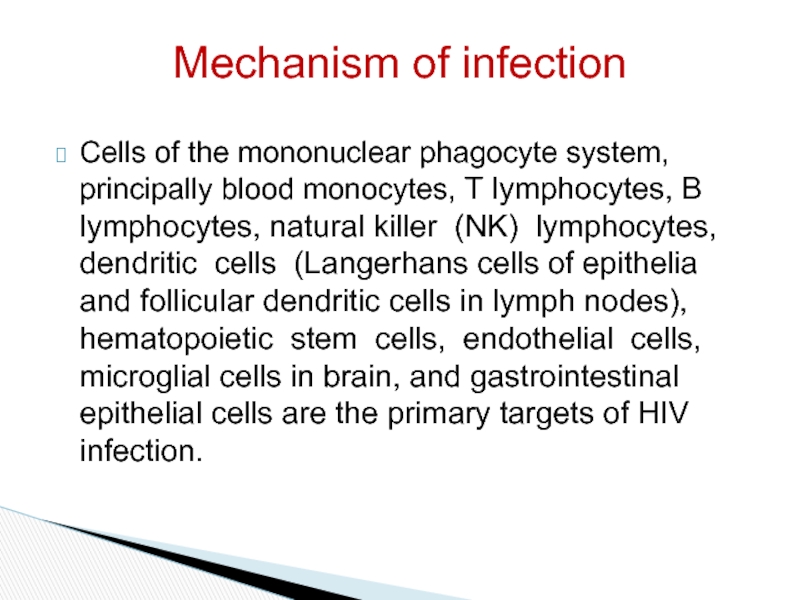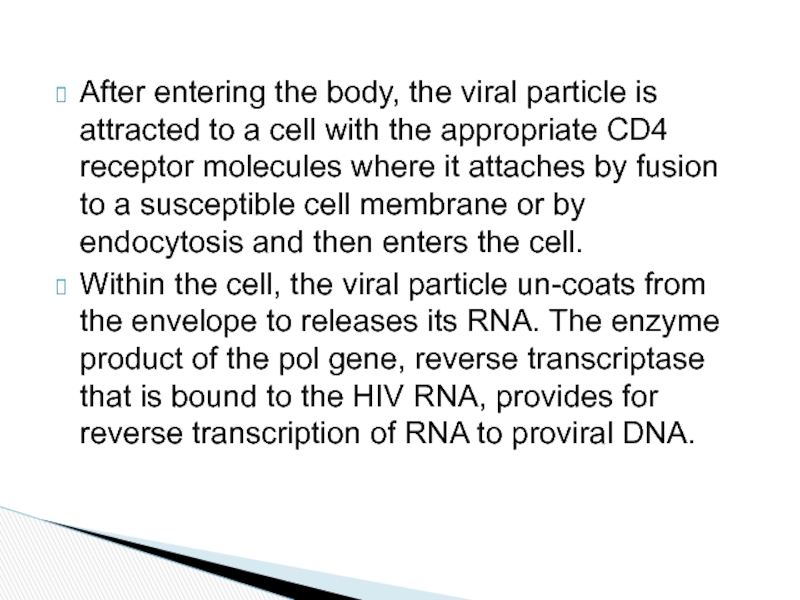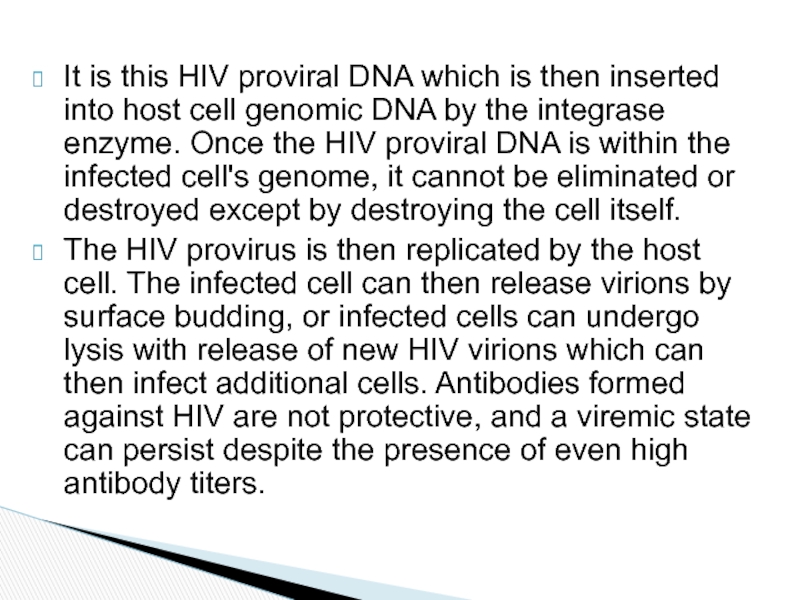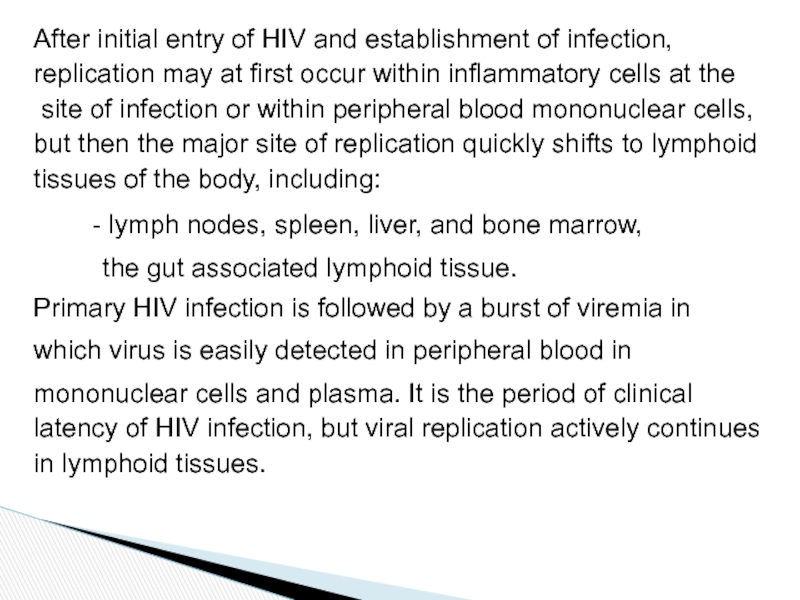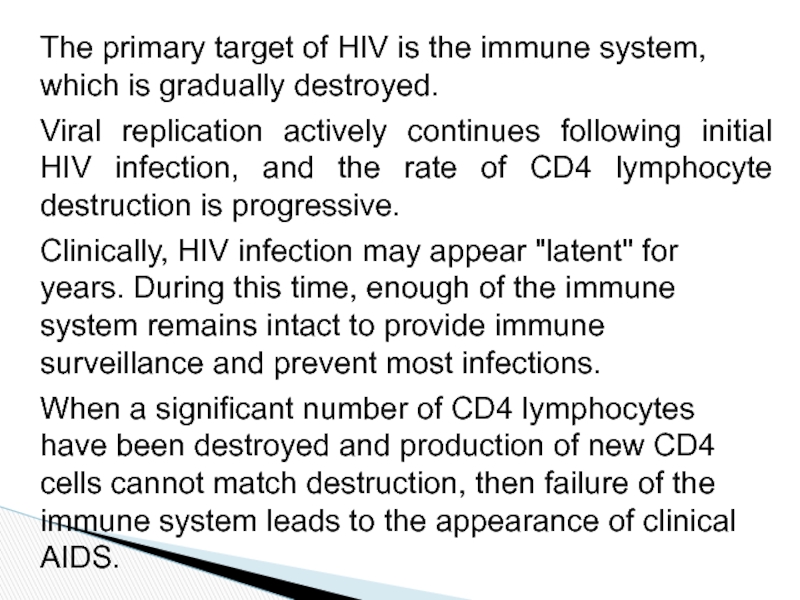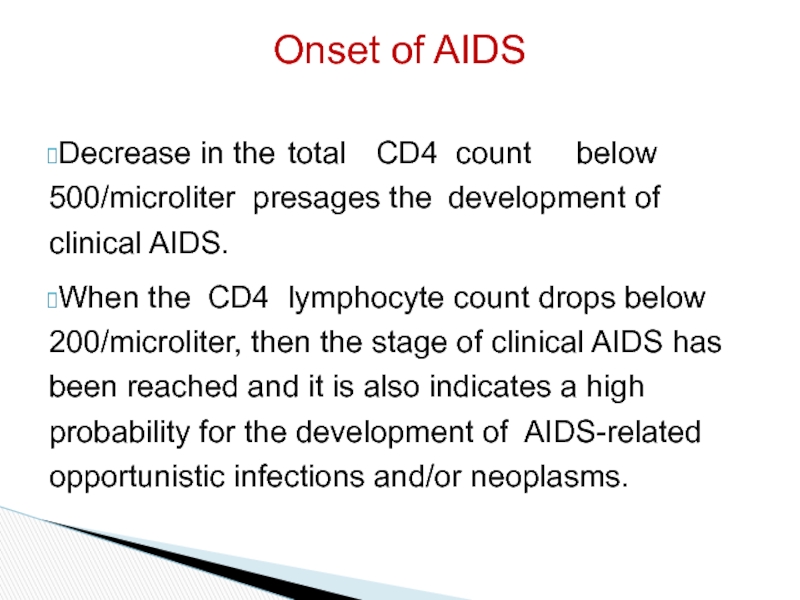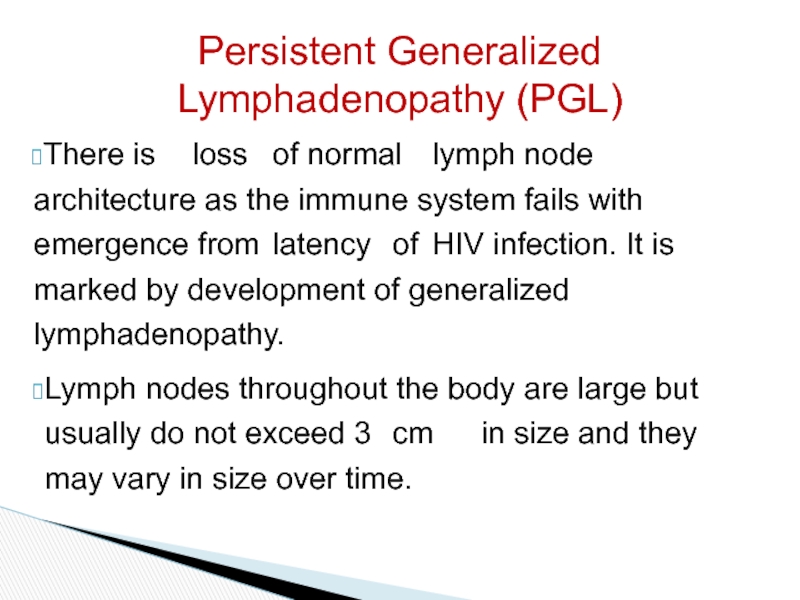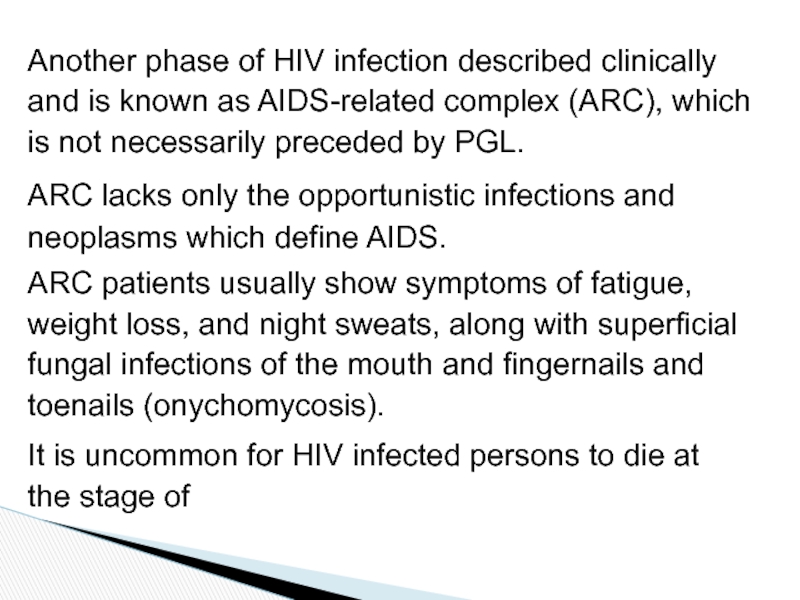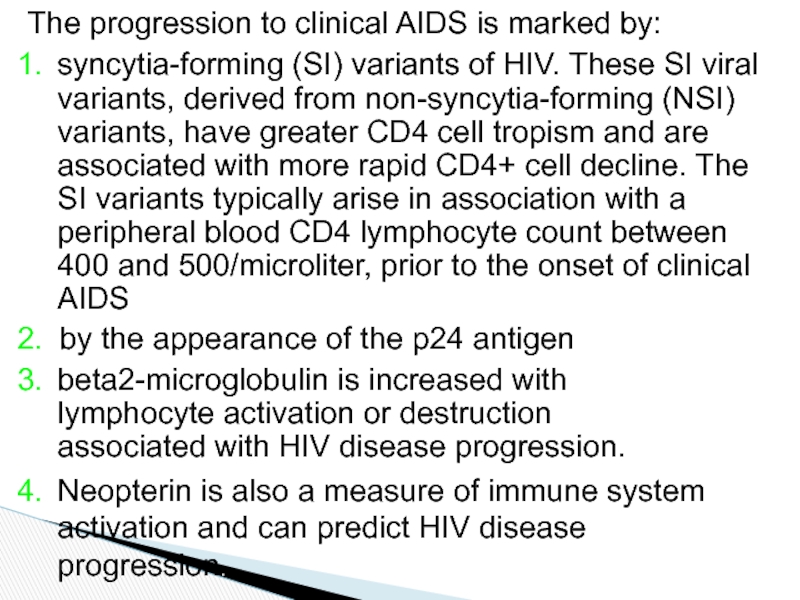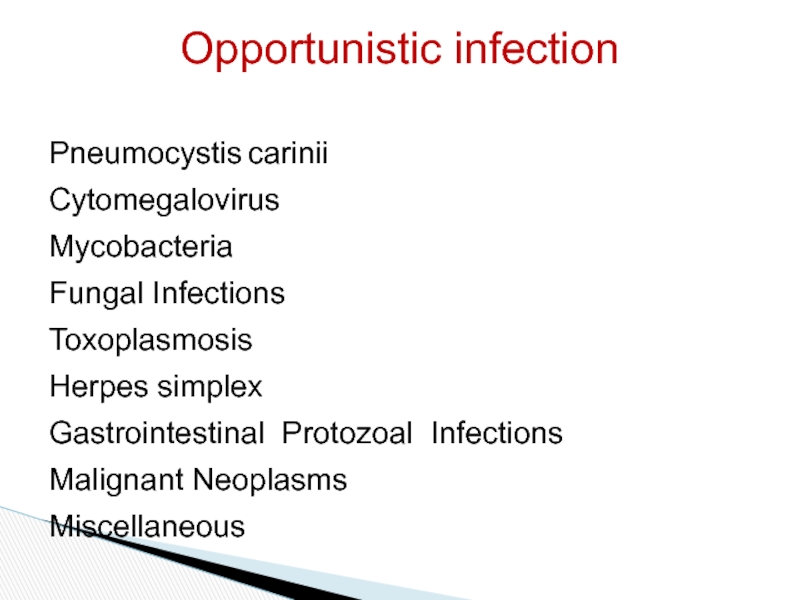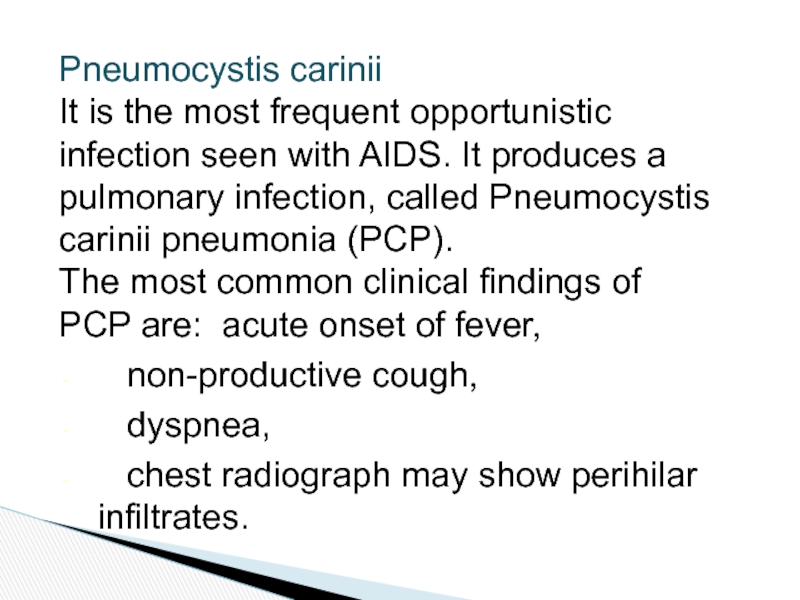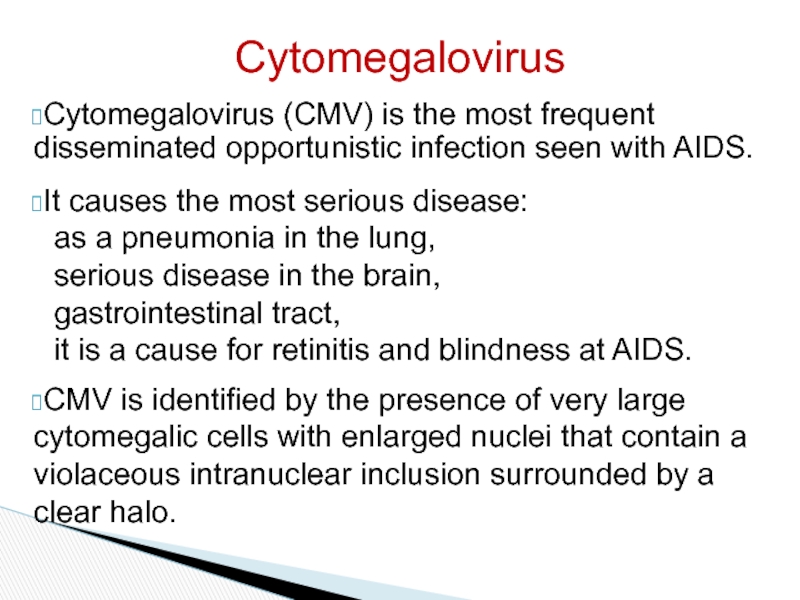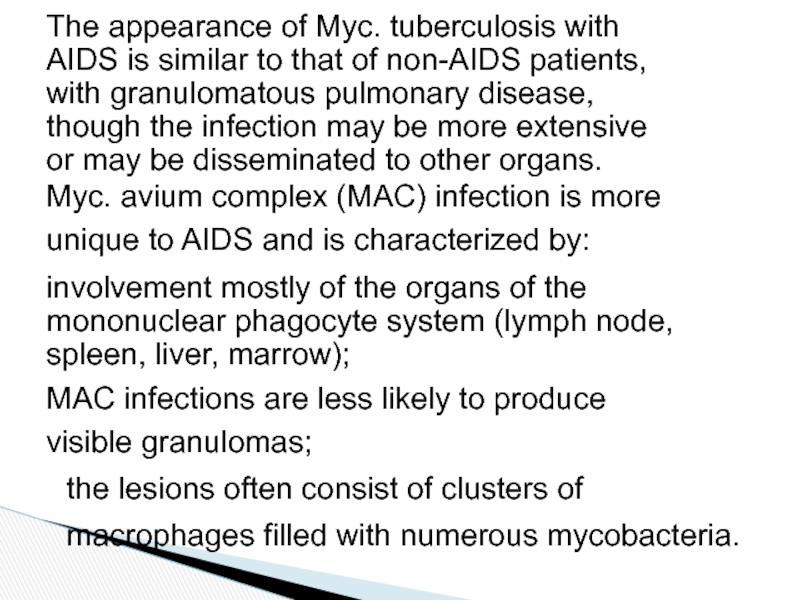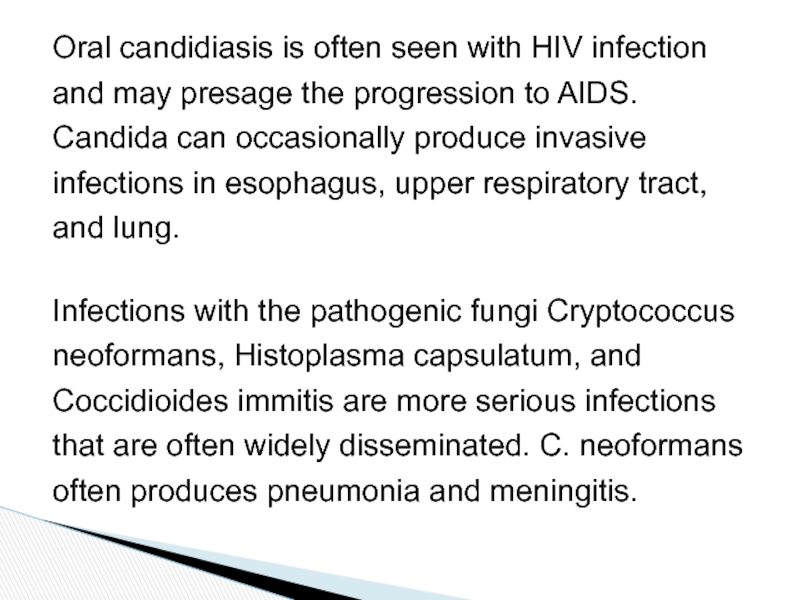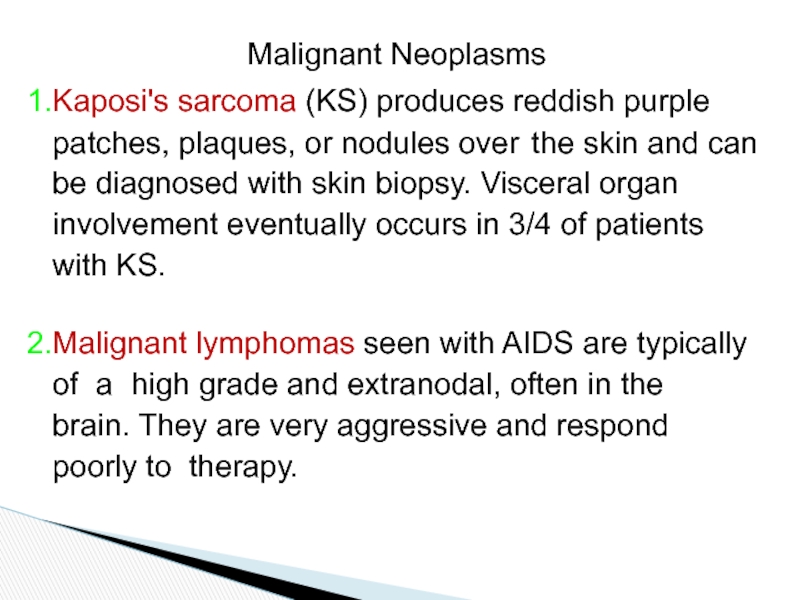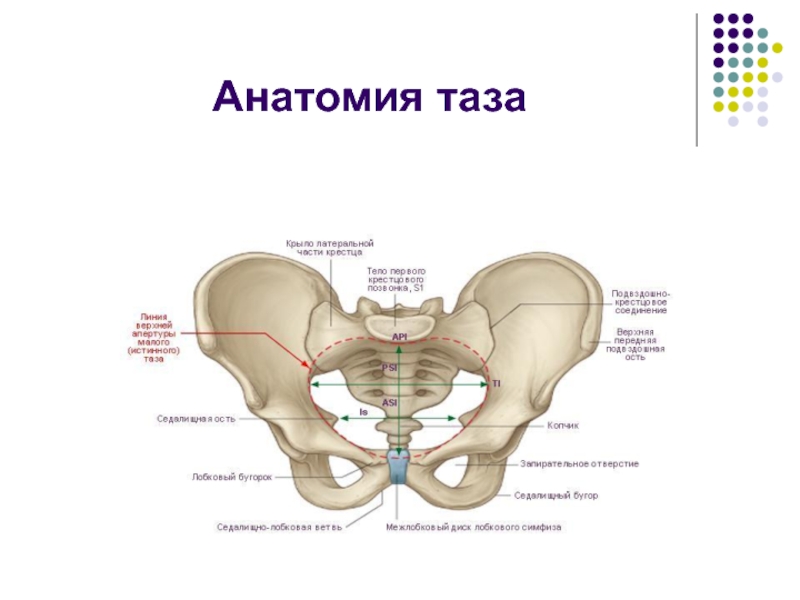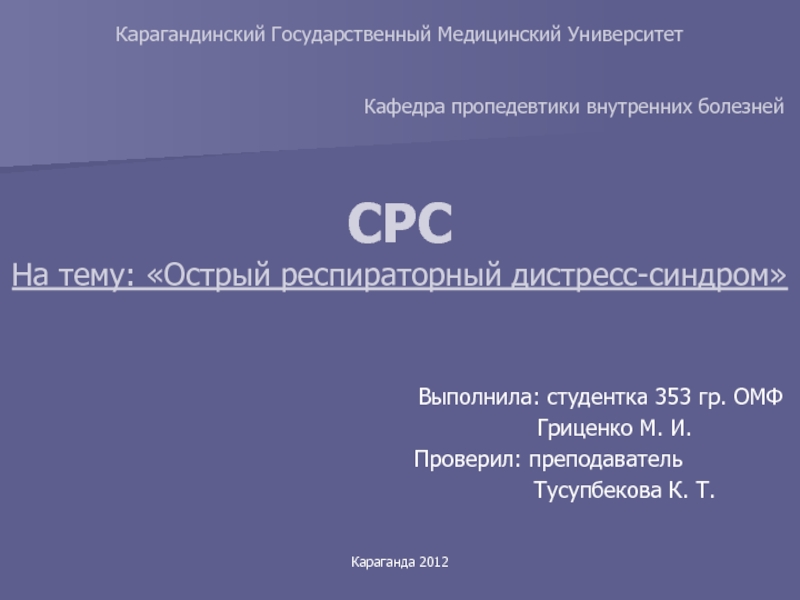- Главная
- Разное
- Дизайн
- Бизнес и предпринимательство
- Аналитика
- Образование
- Развлечения
- Красота и здоровье
- Финансы
- Государство
- Путешествия
- Спорт
- Недвижимость
- Армия
- Графика
- Культурология
- Еда и кулинария
- Лингвистика
- Английский язык
- Астрономия
- Алгебра
- Биология
- География
- Детские презентации
- Информатика
- История
- Литература
- Маркетинг
- Математика
- Медицина
- Менеджмент
- Музыка
- МХК
- Немецкий язык
- ОБЖ
- Обществознание
- Окружающий мир
- Педагогика
- Русский язык
- Технология
- Физика
- Философия
- Химия
- Шаблоны, картинки для презентаций
- Экология
- Экономика
- Юриспруденция
Acquired Immunodeficiency syndrome презентация
Содержание
- 1. Acquired Immunodeficiency syndrome
- 2. HIV is a retrovirus of the lentivirus
- 3. env include- the envelope glycoproteins, the outer
- 4. Major modes of HIV infection spread: As
- 5. The CD4 receptor is known as
- 6. HIV primarily infects cells with CD4 cell-surface
- 7. Cells of the mononuclear phagocyte system, principally
- 8. After entering the body, the viral particle
- 9. It is this HIV proviral DNA which
- 10. After initial entry of HIV and establishment
- 11. The primary target of HIV is the
- 12. Onset of AIDS Decrease in the total
- 13. There is loss of normal lymph node architecture as the
- 14. Another phase of HIV infection described clinically
- 15. The progression to clinical AIDS is marked
- 16. Opportunistic infection Pneumocystis carinii Cytomegalovirus Mycobacteria Fungal
- 17. Pneumocystis carinii It is the most frequent
- 18. Cytomegalovirus (CMV) is the most frequent disseminated
- 19. The appearance of Myc. tuberculosis with AIDS
- 20. Oral candidiasis is often seen with HIV
- 21. Malignant Neoplasms Kaposi's sarcoma (KS) produces reddish
Слайд 1ZAPOROZHZHIAN STATE MEDICAL UNIVERSITY
The department of pathological anatomy and forensic medicine
Acquired
Human immunodeficiency virus (HIV)
Lecture on pathological anatomy for the
3-rd year students
Слайд 2HIV is a retrovirus of the lentivirus family. The variant of
HIV-2 is much less common and less virulent, but eventually produces clinical findings similar to HIV-1 The HIV-1 type itself has a number of subtypes (A through H and O).
Retroviruses are unable to replicate outside of living host cells because they contain only RNA and do not contain DNA.
The result of HIV infection is relentless destruction of the immune system.
All HIV infected persons are at risk for illness and death from opportunistic infectious and neoplastic complications as a result of the AIDS manifestations
Human immunodeficiency virus (HIV)
Слайд 3env include-
the envelope glycoproteins, the outer envelope glycoprotein gp120
transmembrane glycoprotein gp41
the gag gene include –
core nucleocapsid proteins p55, p40, p24 (capsid, or "core" antigen), p17 (matrix), and p7 (nucleocapsid);
pol are - the enzyme proteins p66 and p51 (reverse transcriptase), p11 (protease), and p32 (integrase).
HIV Structure
Слайд 4Major modes of HIV infection spread:
As a sexually transmitted disease. Infection
HIV can be spread via blood or blood products, most commonly with shared contaminated needles used by persons engaging in intravenous drug use.
As a perinatal infection. Mothers who are HIV infected can pass the virus on to their fetuses in uterus or to infants via breast milk.
Pathogenesis. Prevention of Infection
Слайд 5 The CD4 receptor is known as a chemokine that is
Mechanism of infection
Слайд 6HIV primarily infects cells with CD4 cell-surface receptor molecule. Many cell
Mechanism of infection
Слайд 7Cells of the mononuclear phagocyte system, principally blood monocytes, T lymphocytes,
Mechanism of infection
Слайд 8After entering the body, the viral particle is attracted to a
Within the cell, the viral particle un-coats from the envelope to releases its RNA. The enzyme product of the pol gene, reverse transcriptase that is bound to the HIV RNA, provides for reverse transcription of RNA to proviral DNA.
Слайд 9It is this HIV proviral DNA which is then inserted into
The HIV provirus is then replicated by the host cell. The infected cell can then release virions by surface budding, or infected cells can undergo lysis with release of new HIV virions which can then infect additional cells. Antibodies formed against HIV are not protective, and a viremic state can persist despite the presence of even high antibody titers.
Слайд 10After initial entry of HIV and establishment of infection,
replication may
site of infection or within peripheral blood mononuclear cells,
but then the major site of replication quickly shifts to lymphoid tissues of the body, including:
- lymph nodes, spleen, liver, and bone marrow,
the gut associated lymphoid tissue.
Primary HIV infection is followed by a burst of viremia in
which virus is easily detected in peripheral blood in
mononuclear cells and plasma. It is the period of clinical latency of HIV infection, but viral replication actively continues in lymphoid tissues.
Слайд 11The primary target of HIV is the immune system,
which is gradually
Viral replication actively continues following initial HIV infection, and the rate of CD4 lymphocyte destruction is progressive.
Clinically, HIV infection may appear "latent" for years. During this time, enough of the immune system remains intact to provide immune surveillance and prevent most infections.
When a significant number of CD4 lymphocytes have been destroyed and production of new CD4 cells cannot match destruction, then failure of the immune system leads to the appearance of clinical AIDS.
Слайд 12Onset of AIDS
Decrease in the total CD4 count below 500/microliter presages the development
When the CD4 lymphocyte count drops below 200/microliter, then the stage of clinical AIDS has been reached and it is also indicates a high probability for the development of AIDS-related opportunistic infections and/or neoplasms.
Слайд 13There is loss of normal lymph node architecture as the immune system fails with
Lymph nodes throughout the body are large but usually do not exceed 3 cm in size and they may vary in size over time.
Persistent Generalized Lymphadenopathy (PGL)
Слайд 14Another phase of HIV infection described clinically and is known as
ARC lacks only the opportunistic infections and
neoplasms which define AIDS.
ARC patients usually show symptoms of fatigue, weight loss, and night sweats, along with superficial fungal infections of the mouth and fingernails and toenails (onychomycosis).
It is uncommon for HIV infected persons to die at the stage of ARC
Слайд 15The progression to clinical AIDS is marked by:
syncytia-forming (SI) variants of
by the appearance of the p24 antigen
beta2-microglobulin is increased with lymphocyte activation or destruction associated with HIV disease progression.
Neopterin is also a measure of immune system activation and can predict HIV disease progression.
Слайд 16Opportunistic infection
Pneumocystis carinii
Cytomegalovirus
Mycobacteria
Fungal Infections
Toxoplasmosis
Herpes simplex
Gastrointestinal Protozoal Infections
Malignant Neoplasms
Miscellaneous
Слайд 17Pneumocystis carinii It is the most frequent opportunistic infection seen with AIDS.
The most common clinical findings of PCP are: acute onset of fever,
non-productive cough,
dyspnea,
chest radiograph may show perihilar infiltrates.
Слайд 18Cytomegalovirus (CMV) is the most frequent disseminated opportunistic infection seen with
It causes the most serious disease:
as a pneumonia in the lung,
serious disease in the brain,
gastrointestinal tract,
it is a cause for retinitis and blindness at AIDS.
CMV is identified by the presence of very large cytomegalic cells with enlarged nuclei that contain a violaceous intranuclear inclusion surrounded by a clear halo.
Cytomegalovirus
Слайд 19The appearance of Myc. tuberculosis with AIDS is similar to that
Myc. avium complex (MAC) infection is more unique to AIDS and is characterized by:
involvement mostly of the organs of the mononuclear phagocyte system (lymph node, spleen, liver, marrow);
MAC infections are less likely to produce visible granulomas;
the lesions often consist of clusters of macrophages filled with numerous mycobacteria.
Слайд 20Oral candidiasis is often seen with HIV infection and may presage
Infections with the pathogenic fungi Cryptococcus neoformans, Histoplasma capsulatum, and Coccidioides immitis are more serious infections that are often widely disseminated. C. neoformans often produces pneumonia and meningitis.
Слайд 21Malignant Neoplasms
Kaposi's sarcoma (KS) produces reddish purple patches, plaques, or nodules
Malignant lymphomas seen with AIDS are typically of a high grade and extranodal, often in the brain. They are very aggressive and respond poorly to therapy.
